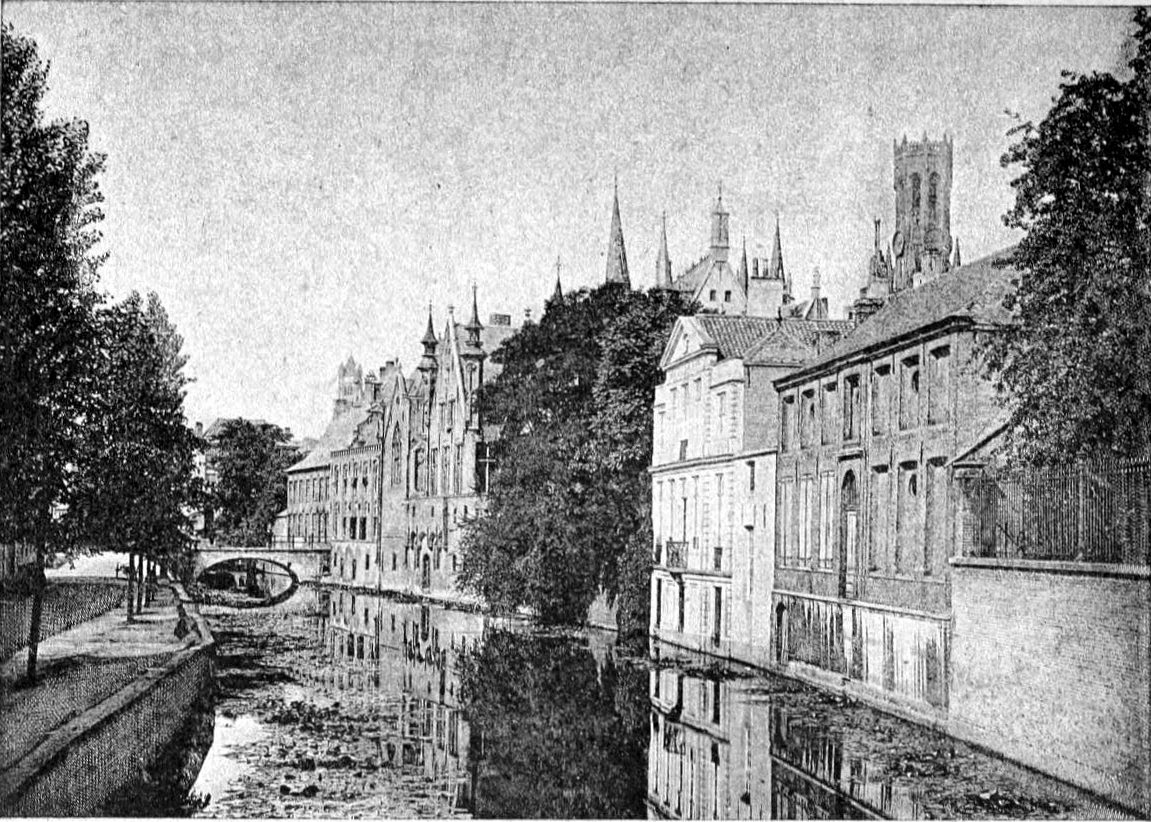I just took the liberty of colour-adjusting the thirty-five beautiful photos by Ch.-G. Petit et Cie (Charles G. Petit & Co.) that illustrate Georges Rodenbach's 1892 novel in French, Bruges-la-Morte: roman (The Dead [City of] Bruges: a novel) - see Bruges-la-Morte (January 2009).
The book was groundbreaking in its use of photography to accompany a novel: a practice still rare, though notably revived by WG Sebald. On first glance, the very calm and static external scenes don't seem much to do with the plot of the novel, which is mostly set indoors and concerns a widower who takes refuge in Bruges to obsessively grieve for his dead wife. He meets a vulgar dancer who is his wife's double - ultimately with tragic consequences when her very different personality clashes with his obsessions. (That is, she makes the bad mistake of messing about with the sacred lock of his wife's hair he keeps on the mantelpiece). If the plot seems familiar, it's because Hitchcock's Vertigo arguably derives from it, via the 1954 French crime novel D'entre les Morts.
However, Rodenbach explains in the preface that the town is not merely a backdrop, but as
On to the original. The photographs in the Internet Archive scan of the 1892 Flammarion edition have a gloomy yellow cast from the fading of the paper ...
... and those on Wikimedia Commons have been converted to monochrome, but without adjusting the brightness and contrast. I don't think there's any 'correct' interpretation, but I think they look quite nice in monochrome and adjusted to the full dynamic range.
- Ray
Mariettas Lautenlied from Korngold's opera
Die Tote Stadt, based on Bruges-la-Morte
The book was groundbreaking in its use of photography to accompany a novel: a practice still rare, though notably revived by WG Sebald. On first glance, the very calm and static external scenes don't seem much to do with the plot of the novel, which is mostly set indoors and concerns a widower who takes refuge in Bruges to obsessively grieve for his dead wife. He meets a vulgar dancer who is his wife's double - ultimately with tragic consequences when her very different personality clashes with his obsessions. (That is, she makes the bad mistake of messing about with the sacred lock of his wife's hair he keeps on the mantelpiece). If the plot seems familiar, it's because Hitchcock's Vertigo arguably derives from it, via the 1954 French crime novel D'entre les Morts.
However, Rodenbach explains in the preface that the town is not merely a backdrop, but as
... an essential character, associated with states of mind, counselling, dissuading, inducing the hero to act ...and that the photographs are to help the readers
... come under the influence of the Town, feel the pervasive presence of the waters from close to, experience for themselves the shadow cast over the text by the tall towers.I don't read French, but this article by James Elkins - 3 / 1 / Georges Rodenbach, Bruges-la-Morte - analyses in detail the tight pertinence of the images to the course of the story. (The whole site, Writing with Images, is worth checking out for its study of works that incorporate images, particularly photographs). Here's the book itself:
- translations from the 2011 Dedalus edition, trans. Mike Mitchell
- Bruges-la-Morte: roman (Georges Rodenbach, Paris: Flammarion, 1892, Internet Archive brugeslamorterom00rode).
- Bruges-La-Morte: A Romance (trans. Thomas Duncan, London: Swan Sonnenschein & Co, 1903, PDF). This is an out-of-copyright English translation scanned and hosted by the Brittle Books Project - a project to scan physically damaged books to make them accessible - at the University of Illinois at Urbana-Champaign Library.
TRANSLATOR’S NOTE—The illustrations referred to in the foregoing preface have been, for the most part, omitted in this translation, as they do not appear to succeed in conveying the imaginative impression intended by M. Rodenbach.
Twit! The Duncan translation appears not to have a good reputation. Comments on it include:
Mr. Duncan, in fact, though as a rule fairly competent, is at times (and those times are more frequent than they should be) annoyingly awkward and unidiomatic. "The tinkle of the accordion" is surely the worst possible phrase. He might as well speak about the sigh of a bell, the clank of a violin, or the clang of a flute.This edition just has three images:
- 'Our Library Table', The Athenaeum, Jan 9th, 1904
.... Thomas Duncan's wholly unsatisfactory - expanded! - rendering ...
- Germanic Notes and Reviews, 1999
Interested Anglophones who did not know French had to have recourse to the stilted translation of 1903 by Thomas Duncan.
- A Baedeker of Decadence: Charting a Literary Fashion, 1884-1927, George C. Schoolfield, 2003
 |
| Georges Rodenbach |
 |
| The Béguinage |
On to the original. The photographs in the Internet Archive scan of the 1892 Flammarion edition have a gloomy yellow cast from the fading of the paper ...
... and those on Wikimedia Commons have been converted to monochrome, but without adjusting the brightness and contrast. I don't think there's any 'correct' interpretation, but I think they look quite nice in monochrome and adjusted to the full dynamic range.
All images from Google scan
Click to enlarge
- Ray





































